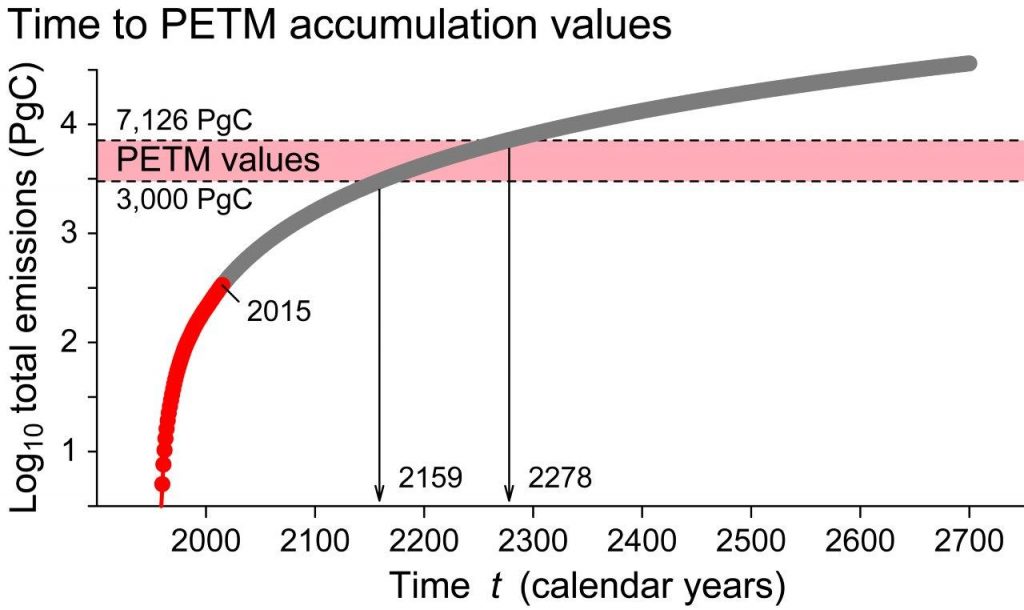20 February 2019
Contact information for the researcher:
Philip Gingerich, +1 (734) 660-4468, [email protected]
AGU press contact:
Lauren Lipuma, +1 (202) 777-7396, [email protected]
University of Michigan press contact:
Jim Erickson, +1 (734) 647-1842, [email protected]

A new study shows humans are pumping carbon dioxide into the atmosphere at a rate nine to 10 times higher than the greenhouse gas was emitted during a global warming event 56 million years ago that made the oceans more acidic and drove some marine species extinct.
Credit: USGS.
WASHINGTON — Total human carbon dioxide emissions could match those of Earth’s last major greenhouse warming event in fewer than five generations, new research finds.
A new study finds humans are pumping carbon dioxide into the atmosphere at a rate nine to 10 times higher than the greenhouse gas was emitted during the Paleocene-Eocene Thermal Maximum (PETM), a global warming event that occurred roughly 56 million years ago.
The results suggest if carbon emissions continue to rise, the total amount of carbon dioxide injected into the atmosphere since humans started burning fossil fuels could equal the amount released during the PETM as soon as 2159.
“You and I won’t be here in 2159, but that’s only about four generations away,” said Philip Gingerich, a paleoclimate researcher at the University of Michigan and author of the new study in the AGU journal Paleoceanography and Paleoclimatology. “When you start to think about your children and your grandchildren, and your great-grandchildren, you’re about there.”
Scientists often use the PETM as a benchmark against which to compare modern climate change. But the new study shows we’re on track to meet this benchmark much sooner than previously thought, as the pace of today’s warming far outstrips any climate event that has happened since the extinction of the dinosaurs.
[ourworldindata image=cumulative-co-emissions]
“Given a business-as-usual assumption for the future, the rates of carbon release that are happening today are really unprecedented, even in the context of an event like the PETM,” said Gabriel Bowen, a geophysicist at the University of Utah who was not connected to the new study. “We don’t have much in the way of geologic examples to draw from in understanding how the world responds to that kind of perturbation.”
The exact environmental consequences of PETM-like carbon levels are unclear, but the increased temperatures will likely drive many species to extinction with the lucky ones being able to adapt or migrate, according to Larisa DeSantis, a paleontologist at Vanderbilt University who was not connected to the new study. In addition, it will take thousands of years for the climate system cool down, she said.
“It’s not just about 100 years from now; it’s going to take significant periods of time for that carbon dioxide to make its way back into the Earth’s crust,” DeSantis said. “It’s not a short-term event. We’re really committing ourselves to many thousands of years of a warmer world if we don’t take action quickly.”
Studying past climate change
The PETM was a global warming event that occurred roughly 56 million years ago. Scientists are unsure what caused it, but during the event massive quantities of carbon dioxide were released into Earth’s atmosphere, rapidly spiking global temperatures by 5 to 8 degrees Celsius (9 to 14 degrees Fahrenheit). Average global temperatures during the PETM peaked at about 23 degrees Celsius (73 degrees Fahrenheit), about 7 degrees Celsius (13 degrees Fahrenheit) higher than today’s average.
Scientists think that during this time and the warm period that followed, the poles were ice-free and the Arctic was home to palm trees and crocodiles. It’s not the hottest Earth has ever been, but the PETM was the warmest period since the extinction of the dinosaurs 66 million years ago.
Scientists can’t pin down exactly how much carbon was injected into the atmosphere during the PETM or exactly how long the event lasted. But their best estimates say between 3,000 and 7,000 gigatons of carbon accumulated over a period of 3,000 to 20,000 years, based on ocean sediment cores that show changes to carbonate minerals laid down during this time.
The massive carbon release and temperature spike drastically altered Earth’s climate, causing a major extinction of organisms in the deep ocean that are a key link in the marine food web. Land animals got smaller and migrated north to cooler climates. Some groups of modern mammals, including primates, appeared for the first time soon after the PETM, but scientists are unsure whether this happened as a direct result of the rapid environmental change.
Comparing past with present
Climate scientists use the PETM as a case study for understanding what environmental changes might happen under current human-caused climate change and when those changes might take effect. But they can only average carbon emissions during the PETM over the whole duration of the event – thousands of years. They don’t know what those emissions rates were like on a yearly basis, so it’s difficult to compare them to the pace of carbon emissions today.
In the new study, Gingerich found a way to mathematically compare modern carbon emissions to PETM emissions on the same time scale. The results showed current carbon emission rates are nine to 10 times higher than those during the PETM.
“To me, it really brought home how rapidly and how great the consequences are of the carbon we’re producing as a people,” Gingerich said.
Projecting current emissions into the future, Gingerich found that if emissions continue to rise, we could be facing another PETM-like event in fewer than five generations. The total carbon accumulated in the atmosphere could hit the lowest estimate of carbon accumulated during the PETM – 3,000 gigatons – in the year 2159. It would hit the maximum estimated emissions – 7,126 gigatons – in 2278, based on Gingerich’s calculations. Humans have emitted roughly 1,500 gigatons of carbon as of 2016.

A model for carbon accumulation over time as the sum of carbon emissions, based on the steady increase in emissions and emission rates since 1959. Red circles are annual accumulations through 2015. If the recent trend in emissions continues, we can expect to reach the minimum estimate for PETM-scale carbon accumulation in the year 2159 and the maximum estimate for PETM-scale carbon accumulation in the year 2278.
Credit: AGU/Paleoceanography and Paleoclimatology/Gingerich 2019.
“The fact that we could reach warming equivalent to the PETM very quickly, within the next few hundred years, is terrifying,” DeSantis said.
The findings suggest scientists may not be able to predict the environmental or biological changes that will happen in the coming years based on what happened during the PETM because today’s warming is occurring so much faster, according to DeSantis. What makes predictions harder is that today’s climate starts from a cooler baseline than the PETM and the species that inhabit Earth are different than those of 56 million years ago.
“It’s hard to compare biotic effects because the world during the PETM was quite different,” DeSantis said. “We live in a very different world today, with different groups of animals, with humans being the dominant species… but we know there are many negative consequences of dramatic warming on vast numbers of species, including our own.”
###
Founded in 1919, AGU is a not-for-profit scientific society dedicated to advancing Earth and space science for the benefit of humanity. We support 60,000 members, who reside in 135 countries, as well as our broader community, through high-quality scholarly publications, dynamic meetings, our dedication to science policy and science communications, and our commitment to building a diverse and inclusive workforce, as well as many other innovative programs. AGU is home to the award-winning news publication Eos, the Thriving Earth Exchange, where scientists and community leaders work together to tackle local issues, and a headquarters building that represents Washington, D.C.’s first net zero energy commercial renovation. We are celebrating our Centennial in 2019. #AGU100
Notes for Journalists
This paper is freely available through March 31. Journalists and public information officers (PIOs) can download a PDF copy of the article by clicking on this link: https://agupubs.onlinelibrary.wiley.com/doi/epdf/10.1029/2018PA003379
Journalists and PIOs may also request a copy of the final paper by emailing Lauren Lipuma at [email protected]. Please provide your name, the name of your publication, and your phone number.
Neither the paper nor this press release is under embargo.
Paper Title:
“Temporal Scaling of Carbon Emission and Accumulation Rates: Modern Anthropogenic Emissions Compared to Estimates of PETM-Onset Accumulation”
Authors:
Philip D. Gingerich: Department of Earth and Environmental Sciences and Museum of Paleontology, University of Michigan, Ann Arbor, Michigan, U.S.A.